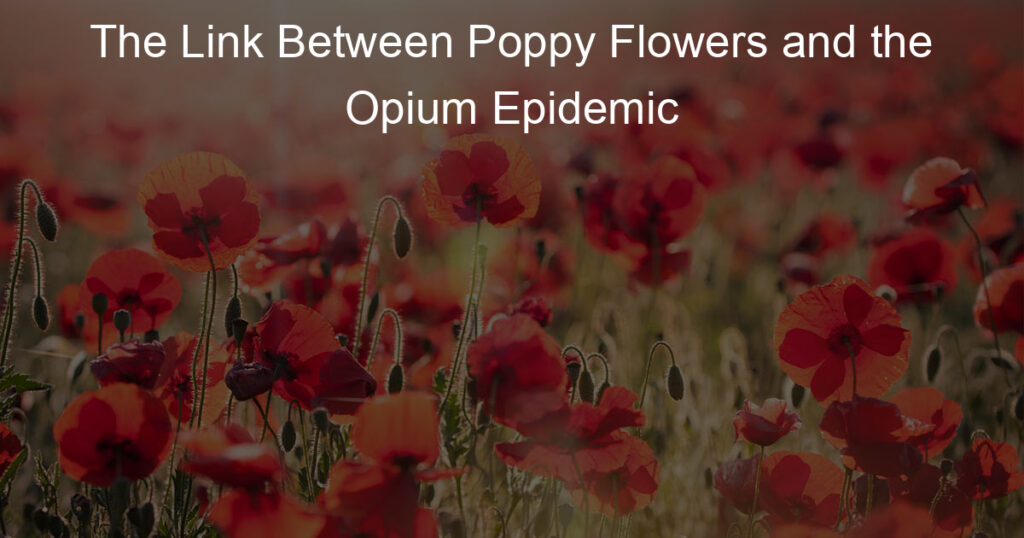Who would have guessed that the delicate poppy flower would be at the center of one of the world’s most devastating drug epidemics? For centuries, opium derived from poppies has been used for medicinal purposes. But in recent years, the illegal production and sale of opium have given rise to a dangerous black market trade. This blog post will explore the link between poppy flowers and the current opioid epidemic sweeping across North America.
What is the relationship between poppy flowers and the opium epidemic?
The connection between poppy flowers and the opium epidemic is an age-old one. Poppies of the family Papaveraceae are a genus of flowering plants noted for their beauty, but unfortunately, also notorious as a source of opium. This drug has been used as a pain reliever or sleep aid since ancient times and up until relatively recently had been firmly entrenched in society. By the 19th century, it had become an epidemic throughout areas of Eastern Europe and Russia, mostly through trafficking that took advantage of poor regulations.
Given the powerful effects of opium’s active ingredients — morphine, codeine, and thebaine — it was not hard to understand why so many people became addicted to such a deadly substance. Even today, poppy flower fields are still treated with extreme caution due to the close ties between these lovely blooms and the worldwide scourge of addiction known as the opium epidemic.
How are poppy flowers used to make opium?
Poppy flowers are versatile and unique flowers that have many uses, one of which is medicinal purposes. People extract a chemical called opium from poppies, which can be used in various medicines to relieve pain. The opium is extracted through a process known as gum-scraping, in which the poppy pod is sliced open to get the milky sap inside. Once collected, this sap is dried and processed into a substance known as raw opium.
Raw opium then goes through further processing to turn it into usable forms such as syrups, pills, or injections depending on its intended use. While poppy flowers may seem like just another pretty petal on the surface, these delicate blooms have an impressive hidden power that offers great benefits to patients in need of pain relief.
Why are poppy flowers so addictive?
Poppies are beautiful flowers, but they also have darker implications. The extract from these flowers is known to be highly addictive and can cause serious physical and psychological dependence. It’s primarily used in the production of opiates, which make up a family of drugs that includes products like morphine, codeine, and oxycodone. What makes them so forceful is the way they interact with the brain — binding to opioid receptors, resulting in a relaxation of inhibitions and feelings of euphoria.
This is why people may seek out poppies as opposed to other substances — they can offer an elevated sensation while they’re under its influence. It’s important to remember that this mind-altering effect comes at a cost: poppies should never be taken lightly due to their addictive qualities.
What is the history of opium use and addiction?
Opium has a long and complex history as a recreational drug, with its first use dating back to the year 3400 BC. Since then, opium addiction has been reported throughout the world, with individuals using opium in various ways such as smoking it in cigars, drinking an alcoholic beverage containing it, or injecting it. One of the most notorious examples of widespread opium use is the creation of laudanum – a psychoactive tincture made from opium – in 1680 by Thomas Sydenham.
The effects of this tincture were so addictive that users soon became increasingly dependent on laudanum for daily life. Eventually, forces such as prohibition and adverse health effects of opioid abuse caused its decline until today’s modern struggles with overused prescription opioids beg for renewed attention on this ancient substance and its ability to wreak havoc on its users’ lives.
How has the opium epidemic affected different countries and cultures?
The global opium epidemic has had a devastating effect on numerous countries and cultures around the world. Addiction to powerful opioids such as heroin and oxycodone influences every aspect of life for those affected, from financial and social stability to public health and safety. In places such as rural Afghanistan or parts of the United States, where drug abuse is particularly high, economic struggles, crime rates, poverty levels, and other forms of social instability can all be directly linked to opioid addiction.
Without comprehensive treatment options and preventative measures in place, this epidemic continues to displace families and communities while destroying entire nations. Drastic urgent action must be taken immediately to stop this vicious cycle.
What are the health effects of opium use?
The use of opium can have a wide range of side effects on an individual’s physical, psychological, and emotional health. Long-term use can lead to extreme addiction and cravings for the substance as well as dependence on it for basic functioning. Additionally, it can cause depression, paranoia, difficulty sleeping, poor eating habits, and adverse changes in behavior or lifestyle.
Opium use also carries a risk of overdose or other medical complications like constipation, respiratory depression, weakened immune system, and increased risk of infections. Since there are very real dangers connected with the acute use of opium – both legal and illegal – it is important to protect oneself by understanding what the risks are before using this or any other substance.
Final Thoughts
As the popularity of poppies continues to grow, it is important to be aware of the history and dangers associated with these flowers. The opium epidemic was a tragic event in history that claimed many lives. While poppy flowers may be beautiful, we must remember the link between these flowers and the Opium Epidemic.














